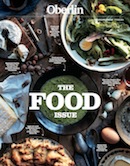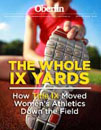Oberlin Alumni Magazine
Summer 2013 Vol. 108 No. 3
Obereactions
Food Delight, Food Fright

At half-past 84, I don’t create complex meals much anymore, but it’s fun to read about Obies who do—and I hang out with locavores. Compliments on the beautiful food issue (Spring 2013). What a well-researched, well-written, well-designed delight!
The latest alumni magazine on food is beautiful and appropriately luscious. The color printing and paper seem much better than previous issues. And I am happy to note an Oberlin grad and a student on the design team. For years it has struck me as odd that Oberlin could not attract a design alumnus. Are we so few?
Food kills! That was my paradoxical reaction to your recent issue celebrating Oberlin’s relationship to nutrition. It’s a weird thought, because for the past million years, all humanoids have faced a daily struggle to get enough calories. Strangely, too much of the wrong foods has become a leading cause of death, disability, and spiraling health care costs, at least in America.
Human history over the previous 10,000 years chronicled a great leap forward in agriculture that increased Earth’s carrying capacity from a few million to a few billion humans. Then, within my lifetime, something big happened: agribusiness.
The American way of business has made us among the most prosperous people in history by harnessing the power of greed to give us more of what we want—whether it’s good for us or not. American agribusiness has boosted our planetary carrying capacity at least ten-fold over the past century and has been so prolific that politicians have frantically sought outlets for the excess, burning it as fuel even when the net impact on the environment is negative, and exporting it to the ruination of small farmers everywhere.
All this would count as an amusing foible were it not for the epidemic of insulin resistance that currently plagues us. Our children are fat, and we are fat; our fitness is falling, and we are dying decades earlier than we need to. All this needless suffering arises from the corruption of our public officials, mostly at the federal level, due to the selfish interests of agribusiness.
So what’s a good Libertarian to do? Please don’t suggest more regulations about what we can eat! Misregulation by gullible, greedy politicians is right at the heart of this problem. Look at the Department of Agriculture’s recommendations for a healthy diet, and you’ll see that nearly half of your calories should come from simple carbohydrates: refined sugars and milled grains. If you want to eat unrefined grains and think that’s healthy, they don’t mind. As long as the U.S. presidential race begins in Iowa, this won’t change.
We can change the American way of death through individual experience and through education. We can lay off the manufactured glop that poisons us, and stick to foods that were available to our ancestors. In some cases, that means going right back to a stone-age diet, as nothing in our past has prepared us for modern grains, fruits, and sugars. It doesn’t take long to see those extra pounds melt away, the sugars and pressures and lipids come down, and the doctor smiles more at our annual checkup. It especially doesn’t take long to find that non-commercial eating feels good.
Then comes the harder job of reforming dietary habits of the masses of people who have trouble affording a healthy diet and wouldn’t even know what that looks or tastes like.

Not Getting Off Scott-Free
I read with much laughter, some awe, and bundles of disbelief the story “The Whole IX Yards” (Fall 2012). In a story that touts the advancement of women’s sports at Oberlin, two words were starkly missing: Jack Scott.
A true history of women’s sports at Oberlin shows that Dr. Scott, the athletics director and chair of the physical education department at the dawning of Title IX, was the enthusiastic leader and moral impetus behind gender equity in Oberlin sports. Indeed, the episode detailed in the story around women’s access to cross country meets occurred while Scott was athletic director and the supervisor of coaches.
Meanwhile, a passing mention of the women’s tiny locker room failed to report that, in one of his first decisions, Scott reduced the size of the men’s faculty locker facilities to provide changing space for tuition-paying women athletes. It was a decision that quickly lived in Yeoman infamy, causing much anger, annoyed chagrin, and heated debate among the tenured academicians who suddenly had less room to hang their towels and store their squash goggles.
I am prepared to stipulate that Jack Scott may have not been a perfect administrator. And I know that airbrushing history, or having one’s own set of facts, is trendy these days. But, please, not at Oberlin, where I enjoyed two special years (1972-74) as an average student, bad athlete, and nuisance sports editor of The Review.
Dr. Scott deserves his due for helping to build the foundation—along with other courageous women and men—upon which the Oberlin women’s athletics program now proudly rests. By ignoring Jack Scott, the story mightily missed its mark and performed a disservice to history.
Oberlin Alumni Magazine welcomes comments
from readers. Please address your letters to:
Oberlin Alumni Magazine
247 W. Lorain St., Suite C
Oberlin, OH 44074-1089
phone: 440.775.8182,
or e-mail: alum.mag@oberlin.edu.
Letters may be edited for clarity and space.
Additional letters may appear on OAM's website
at www.oberlin.edu/oam.
